Ełk
Ełk (Polish pronunciation: [ɛwk]; former Polish: Łek; German: Lyck; Old Prussian: Luks), also seen absent Polish diacritics as Elk, is a city in northeastern Poland with 61,677 inhabitants as of December 2021.[1] It is the seat of Ełk County in Warmian-Masurian Voivodeship. It lies on the shore of Ełk Lake, which was formed by a glacier, and is surrounded by extensive forests. It is the largest city and unofficial capital of historical Masuria. One of the principal attractions in the area is legal hunting.
Ełk | |
|---|---|
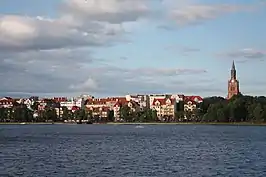  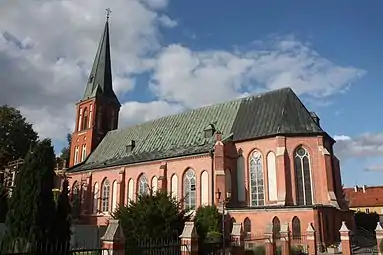
| |
 Flag  Coat of arms | |
 Ełk  Ełk | |
| Coordinates: 53°49′17″N 22°21′44″E | |
| Country | |
| Voivodeship | |
| County | Ełk County |
| Gmina | Ełk (urban gmina) |
| Established | 1237 |
| Town rights | 1445 |
| Government | |
| • City mayor | Tomasz Andrukiewicz |
| Area | |
| • Total | 22.07 km2 (8.52 sq mi) |
| Population (31 December 2021)[1] | |
| • Total | 61,677 |
| • Density | 2,930/km2 (7,600/sq mi) |
| Time zone | UTC+1 (CET) |
| • Summer (DST) | UTC+2 (CEST) |
| Postal code | 19-300 |
| Area code | +48 87 |
| Car plates | NEL |
| Highways | |
| National roads | |
| Website | http://www.elk.pl |
History
Middle Ages
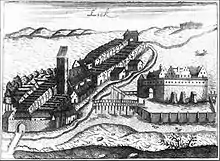
The area where the town of Ełk is located was originally inhabited by Jatvingians, a Baltic peoples, during the early middle ages. By 1281, Skomand the last leader of the pagan Jatvingians, capitulated to the crusading Teutonic Knights, who initially were invited in 1226 by Konrad I of Masovia from the Polish Piast dynasty to put an end to the constant pagan raids into his territory.
After 1323, the northern part of the region was administered by the commandery of Brandenburg, while the larger part with the later town belonged to Balga commandery. A former Old Prussian settlement, the town was first documented in 1398 around a castle built by the Teutonic Knights. The town's name has various postulated origins. Its German version Lyck is postulated to be derived from its Old Prussian name, Luks (from the word for waterlily, luka), while another theory holds that the name comes from Polish word "łęg" meaning meadow.[2] Old Polish names of the town included Łek, Łęg and Łęk. It received its town rights in 1445.
After the outbreak of the Thirteen Years' War in 1454, the town sided with the Prussian Confederation,[3] at whose request the Polish King Casimir IV Jagiellon announced the incorporation of the region into the Kingdom of Poland, which resulted in the town becoming part of the Polish state.[3][4] The town was briefly captured by the Teutonic Knights in 1455, and later on, it was conquered alternately by the Poles and the Teutonic Knights.[5] After 1466 it was a part of Poland as a fief.[6][7]
Early modern era
In 1537, Duke Albert of Prussia donated an estate to Jan Malecki, a Polish printer from Kraków who had either fled[8] or moved to Ducal Prussia for material reasons,[9] to establish a printing house.[10] After converting to Lutheranism, Malecki translated and published Martin Luther's Small Catechism in Polish[11] In 1546 the first school for secondary education in Masuria was founded in the city, where Polish nobles from the Polish–Lithuanian Commonwealth, as well as Poles and Germans from Ducal Prussia were taught in Polish; the position of a Polish teacher remained in place until 1819.[12] Polish pastor, translator, publisher and co-creator of the literary Polish language, Hieronim Malecki, was the school's first rector.[13] In the mid-16th century Ełk was one of the most thriving centers of Polish-language printing. In 1639 the King of Poland Władysław IV Vasa visited the town.[14] It remained under Polish suzerainty until 1660.[15]
18th and 19th centuries
In 1709-10, the plague claimed 1,300 victims.[16] In 1831, 300 people, about 10 percent of the populace, died of the cholera, in 1837 another 80 and 333 in 1852.[17]
.JPG.webp)
In 1825, Lyck was inhabited by 1,748 Germans and 1,394 Poles.[18] At the beginning of the 19th century, a Polish-language school was organised in the city by Tymoteusz Gizewiusz[19] In 1820, Fryderyk Tymoteusz Krieger became the superintendent of the school and actively defended the rights of local Poles to use the Polish language. Kireger also prepared Polish educational programs, in opposition to attempts at Germanization by Prussian authorities.[20]
In 1840, the German-language newspaper "Lycker gemeinnütziges Unterhaltungsblatt", later called "Lycker Zeitung", was founded.[21] Between 1842 and 1845, a Polish newspaper "Przyjaciel Ludu Łecki" (Łek's Friend of the People) was printed in the city, whose aim was to resist Germanisation and cultivate Polish folk traditions as well as educate the local rural population.[22][23]

In May 1845, a Polish resistance movement in the city was organized by Kazmierz Szulc, whose aim was to prepare local Polish youth for an uprising.[24] During the January Uprising, weapons were smuggled through the city to the Russian Partition of Poland, and Polish insurgents fleeing the Russian Partition took refuge in the city; among others, a detachment of Colonel Józef Konstanty Ramotowski passed through it.[25]
In 1885 the city, under its modern name Ełk, was named capital of Masuria by the Geographical Dictionary of the Kingdom of Poland.[26] In the late 19th century it was the largest town of the region (according to data from 1880 and 1890), before being surpassed by Osterode (Ostróda) (according to data from 1905 and 1925).
From 1896 to 1902, "Gazeta Ludowa", a Polish-language newspaper, heavily subsidised by banks from Greater Poland[27][28] representing the Polish national movement in Masuria, was published in the city.[29] It soon faced repression and discrimination from the German authorities which led to its demise;[30] its paid circulation dropped from 357 copies in 1896 to less than 250 at the turn-of-the-century.[31] According to German-American author, Richard Blanke, the "demise marked the end of the second major effort by Polish nationalists to establish a journalistic foothold in Masuria".[32]
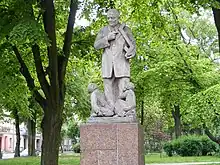
In 1896, Polish and Masurian activists founded the Masurian People's Party in the city, which sought to resist efforts of German authorities at forced Germanization. The co-founder of the party was poet Michał Kajka, today honoured in Ełk with a monument in the centre of the city.[33] From the start, the party was subject to severe repressions and attacks by Prussian authorities.[34] In the German federal elections, the MPL received 229 votes in 1898 and 20 in 1912 in the Lyck constituency.[35]
20th century
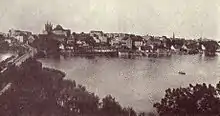
In 1910, Lyck had more than 13,000 inhabitants.[36] Mateusz Siuchniński gives the percentage of Poles in 1900 as 35.7% but warns that the numbers come from lowered German estimates.[37] Many citizens fled during World War I, when Imperial Russian troops attacked the region, but returned after the battles of Tannenberg and the Masurian Lakes. English and Italian troops were deployed in the town after the Treaty of Versailles[38] to supervise the East Prussian plebiscite. The plebiscite was preceded by a campaign of violence and terror by the Germans against the Poles and even against Allied soldiers. The Germans vandalized Polish information boards[39] and held an anti-Polish rally at which they encouraged the beating of Poles and the devastation of their homes and property.[40] In April 1920, the German Sicherheitswehr even battered Italian soldiers, two fatally.[41][42] Voting under such conditions resulted in 8,339 votes for Germany and 8 for Poland, which just regained independence. In 1922, a Polish consular agency was opened, which was upgraded to a vice-consulate the next year.[43]
It was in Lyck that the first-ever weekly newspaper in the Hebrew language, Ha-Magid ("the preacher") was founded in 1856 by Eliezer Lipmann Silbermann, a local rabbi. The paper was eventually moved to Berlin.[44] In Weimar Germany anti-Semitism became prevalent, which led to persecution of the local Jewish population even before the Nazis took power. An anti-Semitic publication, Die jüdische Überlegenheit (The Jewish Supremacy) attacking the Jews circulated in 1927 at a local gathering of fascist sympathizers[45] In 1932, the local pharmacist Leo Frankenstein was attacked; a hand grenade was thrown into his home.[46] The wave of anti-Semitic repressions intensified after Nazis gained power in Germany in 1933 and many local merchants and intellectuals of Jewish descent were arrested.[46] During Kristallnacht, Jewish shops and synagogue were plundered and devastated in the town.[46] Facing these events, several Jews of Lyck decided to escape, some abroad, some to Berlin, others as far as Shanghai[46] Of those Jews who remained, 80 were murdered in various Nazi concentration and death camps.[46]
The city also was the site of German prison camps for Norwegian and Soviet PoWs during World War II.[47][48] The Polish resistance was active and operated one of the region's main smuggling points for underground Polish press in the city.[49] It was heavily damaged by bombardments. The Soviet Army approached in January 1945. The city was placed under Polish administration in April 1945 and the remaining German inhabitants were expelled in accordance with the Potsdam Agreement. It was rebuilt and its modern Polish name Ełk was confirmed as official.
Contemporary times
In 1999, Ełk was visited by Pope John Paul II. About 300,000 people attended a papal Mass.
In 2017, the anti-Muslim Ełk riots occurred after a fatal stabbing of a 21-year-old man by a Muslim kebab cook. Several hundred men surrounded the Prince Kebab restaurant,[50][51] tossing firecrackers, stones, and Molotov cocktails at the shop.[52] Police initially stood by and did not intervene for several hours; however, when they did intervene the crowd turned against them as well.[52] Following the riots in Ełk, other attacks on kebab restaurants took place throughout Poland.[52]
In 2018, on the occasion of the 100th anniversary of Poland's independence, a monument to Józef Piłsudski was erected in front of the town hall.[53] The Marshal of Poland was also honored with a mural on one of the townhouses in the city center.[54]
Population
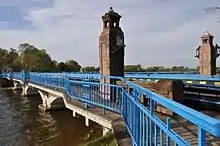
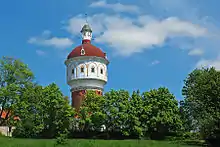
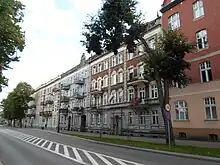
Number of inhabitants by year
| Year | Number |
|---|---|
| 1499 | 600 |
| 1600 | 800 |
| 1782 | 2,000 |
| 1831 | 2,945 |
| 1875 | 5,912 |
| 1880 | 6,846 |
| 1890 | 9,981 |
| 1925 | 15,159 |
| 1933 | 15,512 |
| 1939 | 16,243 |
| 2010 | 61,156 |
| 2011 | 59,274 |
| 2017 | 61,523 |
Note that the above table is based on primary, possibly biased, sources:[44][55][56][57][58][59]
Demographic changes
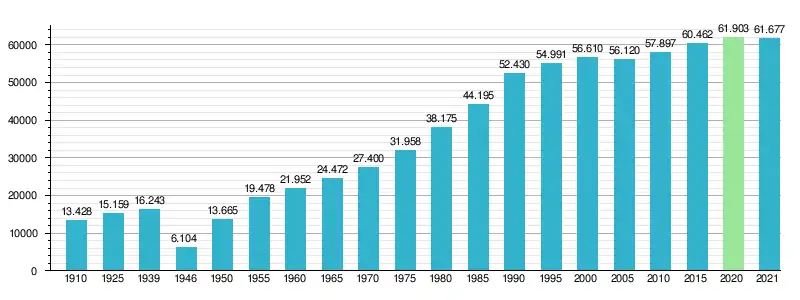
Districts
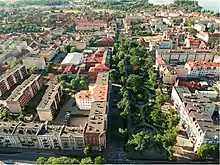
The city of Ełk is divided into 13 administrative units, known in Polish as osiedla:
- Baranki
- Centrum
- Jeziorna
- Konieczki
- Osiedle Bogdanowicza
- Osiedle Grunwaldzkie
- Osiedle Kochanowskiego
- Osiedle Tuwima
- Osiedle Wczasowe
- Pod Lasem
- Północ I
- Północ II
- Szyba
- Zatorze
Notable people
- Arthur Ludwich (1840–1920), German classical philologist who specialized in Homeric studies
- Charles Edward Moldenke (1860–1935), American Lutheran minister and Egyptologist
- Theodor Simon Flatau (1860–1937), German physician
- Karol Bahrke (1868–1935), Polish activist, journalist and book publisher
- Otto von Schrader (1888–1945), German admiral
- Theodor Horydczak (1889–1971), American photographer
- Alfred Müller (1905–1959), German middle-distance runner, competed in the 1928 Summer Olympics
- Kurt Symanzik (1923–1983), German physicist
- Siegfried Lenz (1926–2014), German author; honorary citizen of Ełk since 2011.[60]
- Klaus Gerwien (1940–2018), German soccer player
- Leszek Błażyński (1949–1992), Polish boxer
- Roman Czepe (born 1956), Polish politician
- Andrzej Zgutczyński (born 1958), Polish footballer
- Dariusz Zgutczyński (born 1965), Polish footballer
- Cezary Zamana (born 1967), Polish cyclist
- Paweł Sobolewski (born 1979), Polish footballer
- Tomasz Abramowicz (born 1979), Polish footballer
Mayors
- Adam Puza (1990–1994)
- Zdzisław Fadrowski (1994–2002)
- Janusz Nowakowski (2002–2006)
- Tomasz Andrukiewicz (since 2006)
Education
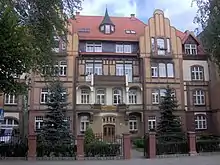
- Private Economic Academy
- Nursery School
- Higher Catholic Seminary
High schools
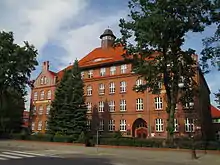
- Zespół Szkół Ekonomicznych
- Zespół Szkół Mechaniczno - Elektrycznych
- Zespół Szkół nr 1
- Zespół Szkół nr 2 im. K. K. Baczyńskiego (swww)
- Zespół Szkół nr 3 im. J. H. Małeckich (www)
- I Liceum Ogólnokształcące im. S. Żeromskiego (www)
- Zespół Szkół Rolniczych im. M. Rataja
- Zespół Szkół Samorządowych
- Zespół Szkół nr.6 im. M. Rataja (www)
Sports
Local sports clubs include football club Mazur Ełk, boxing club Mazur Ełk, cycling club LUKK Ełk, judo club MKS Żak Ełk and basketball club Wilki Ełk.
The Polish Cyclo-cross Championships were held in Ełk in 1998, 2005 and 2012.
Religion
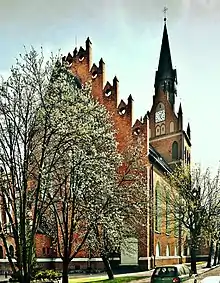
Since the medieval Christianization of the region, the city's population was Roman Catholic, and after the Reformation, it was almost entirely Lutheran until World War II. After the war, the main religion in Ełk became again Roman Catholicism, although a number of Protestant churches are also represented and play an important role in the religious life of the population. These include the Methodist, Baptist, Pentecostal (Assemblies of God - Kościół Zielonoświątkowy) and other churches. Ełk is the center of the Catholic Diocese of Ełk with its bishop Jerzy Mazur.
International relations
Twin towns and sister cities
Former twin towns:
In March 2022, Ełk ended its partnership with the Russian city of Ozyorsk as a reaction to the 2022 Russian invasion of Ukraine.[62]
Coat of arms
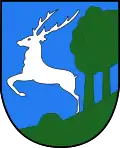
The current coat of arms of Ełk were adopted in 1999, after the town was visited by the Pope John Paul II. The colors have been changed (from green to yellow), the deer is different than in the former emblem. Lastly is the addition of the insignia of the Papacy.
Until 1967, a different emblem with the two-faced head of the god Janus was used, but its origin is unknown.[63]
Gallery
 Baptist church
Baptist church Town hall
Town hall Bridge on the Ełk Lake
Bridge on the Ełk Lake Polish War Cemetery
Polish War Cemetery Józef Piłsudski monument
Józef Piłsudski monument Ełk railway station
Ełk railway station The Ełk narrow gauge railway station
The Ełk narrow gauge railway station Solidarity Park at night
Solidarity Park at night District Court
District Court Technical school
Technical school John Paul II Square
John Paul II Square Ełk bypass route
Ełk bypass route Promenade
Promenade Shopping mall
Shopping mall Southern districts of Szyba and Jeziorna
Southern districts of Szyba and Jeziorna
Further reading
- Kończal, Kornelia (ed.), Ełk w dokumentach archiwalnych (część 1: lata 1945–1947), ed. with Rafał Żytyniec, in: Ełcki Przegląd Historyczny, vol. 2, 2016–2019, p. 144–217.
References
- "Local Data Bank". Statistics Poland. Retrieved 2022-08-02. Data for territorial unit 2805011.
- Program Rewitalizacji Ełku, page 20 Załącznik nr 1 do Uchwały Nr LIII/493/10 Rady Miasta Ełku z dnia 25 maja 2010 roku
- Klimowicz, Robert (2009). Ełk. Karty z dziejów miasta i okolic (in Polish). Ełk. p. 56.
{{cite book}}: CS1 maint: location missing publisher (link) - Górski, Karol (1949). Związek Pruski i poddanie się Prus Polsce: zbiór tekstów źródłowych (in Polish). Poznań: Instytut Zachodni. p. 54.
- Klimowicz, Robert (2009). Ełk. Karty z dziejów miasta i okolic (in Polish). Ełk. p. 57.
{{cite book}}: CS1 maint: location missing publisher (link) - Górski, pp. 96–97, 214–215
- Klimowicz, Robert (2009). Ełk. Karty z dziejów miasta i okolic (in Polish). Ełk. p. 19.
{{cite book}}: CS1 maint: location missing publisher (link) - Kossert, Andreas (2005). Ostpreussen – Geschichte und Mythos (in German). Siedler. p. 60. ISBN 3-88680-808-4.
Seit 1537 entfaltete der aus Polen geflüchtete protestantische Pfarrer Jan Maletius eine rege Übersetzungstätigkeit in Lyck
- Frick, David (1989). Polish Sacred Philology in the Reformation and the Counter-Reformation: Chapters in the History of the Controversies (1551-1632). University of California Press. p. 13. ISBN 0520097408.
-
- Popp, Dietmar; Suckale, Robert (2002). Die Jagiellonen: Kunst und Kultur einer europäischen Dynastie an der Wende zur Neuzeit (in German). Germanisches Nationalmuseum. p. 205. Retrieved 30 January 2012.
*Hołd pruski
*Archiwa, biblioteki i muzea kościelne, Tomy 69-70 Katolicki Uniwersytet Lubelski. Ośrodek Archiwów, Bibliotek i Muzeów Kościelnych, page 131 1998 - Popp, Dietmar; Suckale, Robert (2002). Die Jagiellonen: Kunst und Kultur einer europäischen Dynastie an der Wende zur Neuzeit (in German). Germanisches Nationalmuseum. p. 205. Retrieved 30 January 2012.
- Jakobson, Roman (1985). Selected Writings: Early Slavic Paths and Crossroads. Walter de Gruyther. p. 51. ISBN 3-11-010605-1. Retrieved 30 January 2012.
- Dzieje Warmii i Mazur w zarysie, Tomy 1-2 Jerzy Sikorski, Stanisław Szostakowski, Ośrodek Badań Naukowych im. Wojciecha Kętrzyńskiego w Olsztynie Państwowe Wydawnictwo Naukowe, page 190, 1981
- Memorial plaque on the Zespół Szkół Mechaniczno–Elektrycznych w Ełku, photo
- Komunikaty Mazursko-Warmińskie 2, 2006, p. 231 (in Polish)
- Confirmed by the Treaty of Oliva of 1660.
- Kossert, Andreas (2006). Masuren. Ostpreußens vergessener Süden (in German). Pantheon. ISBN 3-570-55006-0.
Kossert, Andreas (2004). Mazury, Zapomniane południe Prus Wschodnich (in Polish). ISBN 83-7383-067-7. - Kossert, Andreas (2001). Masuren - Ostpreussens vergessener Süden. p. 132. ISBN 3-570-55006-0.
- Historia Pomorza:(1815-1850), Gerard Labuda, Poznańskie Towarzystwo Przyjaciół Nauk, page 157, 1993
- Karty z dziejów Mazur: wybór pism, Tom 1 Emilia Sukertowa-Biedrawina Pojezierze, page 68, 1972.
- Tadeusz Oracki, page 173, Instytut Wydawniczy Pax, 1983.
- Weber, Reinhold (1983). Masuren: Geschichte, Land und Leute (in German). Rautenberg. p. 200. Retrieved 30 January 2012.
- Wielka encyklopedia powszechna PWN: Polska-Robe Bogdan Suchodolski, Państwowe Wydawnictwo Naukowe, page 566, 1967
- Koncepcje i rozwój literatury dla ludu w latach 1773–1863 Eugenia Sławińska, Wyższa Szkoła Pedagogiczna w Bydgoszczy, page 45 1996
- Rocznik gdański, Tom 48, Wydanie 2 Gdańskie Towarzystwo Naukowe, Gdańskie Towarzystwo Naukowe. Wydział I--Nauk Społecznych i Humanistycznych Gdańskie Towarzystwo Naukowe, page 73, 1990
- Groniewska, Barbara (1960). "Rola Prus Wschodnich w powstaniu styczniowym". Komunikaty Mazursko-Warmińskie (in Polish). No. 1. pp. 6, 16, 22.
- Słownik geograficzny Królestwa Polskiego i innych krajów słowiańskich, Tom VI (in Polish). Warszawa. 1885. p. 206.
{{cite book}}: CS1 maint: location missing publisher (link) - Blanke, Richard (2001). Polish-speaking Germans? Language and national identity among the Masurians since 1871. Böhlau. p. 65. ISBN 3-412-12000-6.
- Kossert, Andreas (2001). Masuren - Ostpreussens vergessener Süden (in German). Siedler. p. 210.
1896 wurde die Gazeta Ludowa (Volkszeitung) gegründet, die zum großen Teil von Banken aus Großpolen massiv unterstützt wurde. Nach einem Jahr hatte die hochsubventionierte Zeitung eine auflage von 2500 Exemplaren erreicht
- Zarys historii polskiego ruchu ludowego: makieta: Tom 1 Zjednoczone Stronnictwo Ludowe. Naczelny Komitet. Zakład Historii Ruchu Ludowego, Stanisław Kowalczyk, Józef Kowal, page 223- 1963
- Szkice z dziejów Pomorza: Pomorze na progu dziejów najnowszych, Gerard Labuda Książka i Wiedza,"12.Gazeta Ludowa w Ełku", page 303 1961
- Richard Blanke:"Polish-speaking Germans", pages 68, 72
- Richard Blanke:"Polish-speaking Germans", page 73
- Kraj a emigracja: ruch ludowy wobec wychodźstwa chłopskiego do krajów Ameryki Łacińskiej (do 1939 roku) Jerzy Mazurek, page 281, Biblioteka Iberyjska, 2006
- Richard Blanke:"Polish-speaking Germans", p. 71.
- Andreas Kossert: Masuren - Ostpreußens vergessener Süden, page 33
- Siuchniński, Mateusz (1965). Miasta polskie w tysiącleciu: Tom 1 (in Polish). Zakład Narodowy im. Ossolińskich. p. 275.
- Butler, Rohan, Massachusetts., Bury, J.P.T., MA., & Lambert M.E., MA., editors, Documents on British Foreign Policy 1919-1939, 1st Series, Her Majesty's Stationery Office, London, 1960, vol.x, Chapter VIII, "The Plebiscites in Allenstein and Marienwerder January 21 - September 29, 1920"
- "W Warmji i na Mazurach". Robotnik (in Polish). No. 163 (951). Warszawa. 18 June 1920. p. 4.
- "Hakatyści w sutannie". Gazeta Polska dla Powiatów Nadwiślańskich (in Polish). No. 55. Kwidzyn. 5 June 1920. p. 4.
- "Wiadomości potoczne". Gazeta Gdańska (in Polish). No. 85. Gdańsk. 13 April 1920. p. 3.
- "Na Mazurach". Czas (in Polish). No. 90. Kraków. 15 April 1920. p. 4.
- Ceranka, Paweł; Szczepanik, Krzysztof (2020). Urzędy konsularne Rzeczypospolitej Polskiej 1918–1945. Informator archiwalny (in Polish). Warszawa: Naczelna Dyrekcja Archiwów Państwowych, Ministerstwo Spraw Zagranicznych. p. 129. ISBN 978-83-65681-93-5.
- Historical Jewish Press website; retrieved May 21, 2014.
- Archived 2016-03-09 at the Wayback Machine Virtual Sztetl
- Ełk History
- Teczka specjalna J.W. Stalina: raporty NKWD z Polski 1944-1946 (in Polish). Instytut Studiów Politycznych Polskiej Akademii Nauk. p. 159.
- Okęcki, Stanisław (1965). Cudzoziemcy w polskim ruchu oporu: 1939-1945 (in Polish). Interpress. p. 136.
- Chrzanowski, Bogdan (2022). Polskie Państwo Podziemne na Pomorzu w latach 1939–1945 (in Polish). Gdańsk: IPN. p. 57. ISBN 978-83-8229-411-8.
- Zawadzka, Anna. "Drinking vodka with anti-Semites. A case study of ‘Polish-Jewish relations’ today." Adeptus 11 (2018): 1-23.
- Tunisian charged over Poland stabbing that sparked riot, BBC, 2 January 2017
- Died by the kebab knife, NRC Handelsblad, 29 December 2017, Roeland Termote & Pieter van Os
- "Ełk: Pomnik Marszałka Piłsudskiego na 100-lecie Niepodległości, Ełkdlawas.info". Retrieved June 2, 2019.
- "Nowy mural na 100-lecie niepodległości, Miasto Ełk - tu wracam". Retrieved June 2, 2019.
- (in Polish)
- (in Polish)
- August Eduard Preuß: Preußische Landes- und Volkskunde. Königsberg 1835, pp. 454–455, no. 65.
- wspolczesna.pl (in Polish)
- Johann Friedrich Goldbeck: Volständige Topographie des Königreichs Preussen. Part I: Topographie von Ost-Preussen, Marienwerder 1785, p. 39, no. 2.
- "Siegfried Lenz zum Ehrenbürger seiner Geburtsstadt ernannt" (in German). Hamburger Abendblatt. Retrieved 2011-11-18.
- Ełk - Współpraca międzynarodowa. Narodowy Instytut Samorządu Terytorialnego (in Polish). Retrieved 2022-08-02.
- "Warmińsko-mazurskie: Ełk zerwał współpracę z rosyjskim miastem Oziersk" (in Polish). Retrieved 13 March 2022.
- "Ełk - Przedwojenny herb miasta". Castles of Poland. 2003-04-30. Retrieved 2009-05-05.
External links
- Municipal website (in Polish)
- Ełk information (in Polish)
- Jewish community of Ełk on Virtual Shtetl
- Google satellite photo

